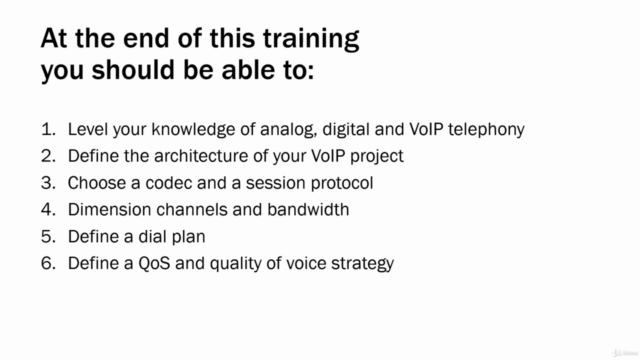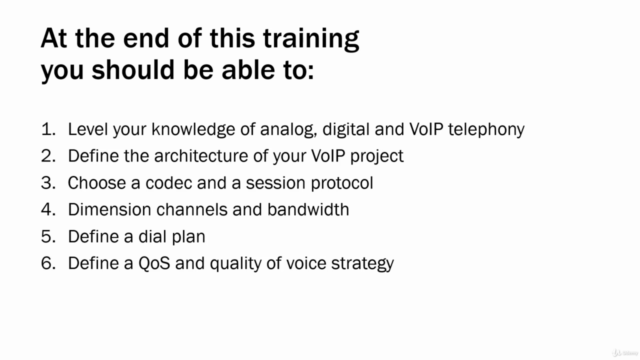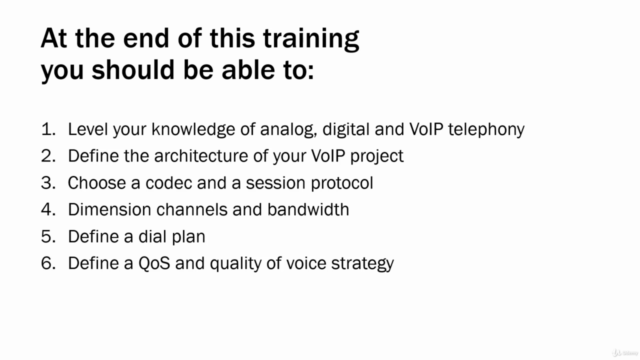VoIP Design and Telephony Fundamentals

Why take this course?
📢 Course Title: VoIP Design and Telephony Fundamentals
🚀 Course Headline: Prepare for Your VoIP Project Like a Pro!
🔍 Course Description:
Over the past year, I've had the pleasure of guiding companies embarking on new VoIP projects through this comprehensive course. It's an ideal boot camp for those with a fledgling understanding of telephony and voice over IP (VoIP) networks. This course starts with the basics of conventional telephony, delving into the world of analog and digital systems before diving deep into the essence of VoIP.
Here's what you can expect from this course:
-
Analog Telephony: We kick off by exploring the fundamentals of analog telephony, including FXS, FXO, and E+M interfaces. Understanding how to integrate a VoIP network with the Public Switched Telephone Network (PSTN) is crucial for any successful implementation.
-
Digital Telephony: Next, we delve into digital telephony realms such as T1/E1 networks, CAS (Channel Associated Signaling), CCS (Common Channel Signaling), and the global standard for integrated services, ISDN. We also focus on MFC/R2 protocols commonly found in regions like Latin America, Africa, and China.
-
VoIP Fundamentals: This section is where we cover the core concepts of VoIP, including codec selection and channels and bandwidth dimensioning. You'll learn how to determine the number of channels needed for your busiest hour and use a VoIP calculator to assess the required bandwidth.
-
Designing for Voice Quality: We dive into the science behind ensuring top-notch voice quality, discussing the R-Factor, MOS (Mean Opinion Score), and providing you with utilities to measure voice quality in your network.
-
Legacy Integration: In this practical section, we address the reality that most projects involve integrating with existing legacy systems. We'll explore how to handle this integration effectively, ensuring survivability and performance.
-
QoS for Routers and Switches: This is where we get into the nitty-gritty of Quality of Service (QoS). You'll learn about classification and marking, fragmentation and interleaving, compressed RTP in PPP circuits, queueing strategies like Low Latency Queuing, and tail drop prevention techniques. We'll also walk through live demos for implementing QoS on Cisco routers and switches.
-
Voice VLANs: Finally, we cover the importance of Voice VLANs for security and protection against broadcast storms in environments such as hotels and universities.
🎓 Why This Course?
In my journey with open source PBXs since 2004, I've noticed a significant gap: many professionals working on open source telephony lack a background in network design. Unlike proprietary vendors, open source projects often don't enforce best practices related to dimensioning, QoS, and integration with legacy systems. This course aims to bridge that gap by providing you with the knowledge and tools necessary for a successful VoIP deployment.
🔄 Course Updates:
The telecommunications landscape is ever-evolving, and so is this course. I'm committed to updating it regularly to keep pace with new technologies and devices. As a course participant, you'll benefit from lifetime access, ensuring you always stay up-to-date with the latest information.
📚 Join the Journey:
Embark on your journey towards mastering VoIP design and telephony by enrolling in this comprehensive and practical course today! Let's build a solid foundation together and prepare for your next VoIP project like a true professional. 🚀📡🗫️
Course Gallery




Loading charts...